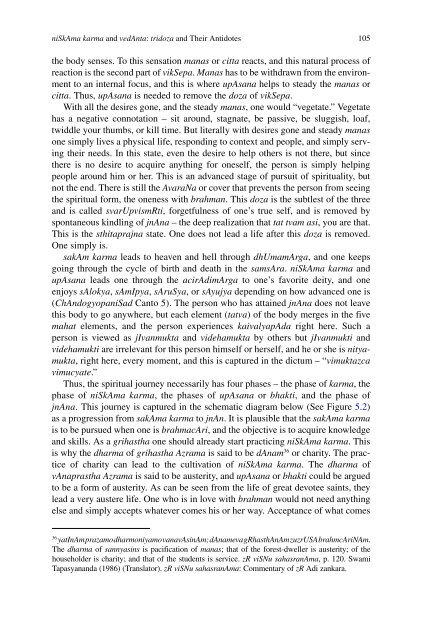Spirituality and Indian Psychology: Lessons from ... - Mandhata Global
Spirituality and Indian Psychology: Lessons from ... - Mandhata Global
Spirituality and Indian Psychology: Lessons from ... - Mandhata Global
You also want an ePaper? Increase the reach of your titles
YUMPU automatically turns print PDFs into web optimized ePapers that Google loves.
niSkAma karma <strong>and</strong> vedAnta: tridoza <strong>and</strong> Their Antidotes<br />
the body senses. To this sensation manas or citta reacts, <strong>and</strong> this natural process of<br />
reaction is the second part of vikSepa. Manas has to be withdrawn <strong>from</strong> the environment<br />
to an internal focus, <strong>and</strong> this is where upAsana helps to steady the manas or<br />
citta. Thus, upAsana is needed to remove the doza of vikSepa.<br />
With all the desires gone, <strong>and</strong> the steady manas, one would “vegetate.” Vegetate<br />
has a negative connotation – sit around, stagnate, be passive, be sluggish, loaf,<br />
twiddle your thumbs, or kill time. But literally with desires gone <strong>and</strong> steady manas<br />
one simply lives a physical life, responding to context <strong>and</strong> people, <strong>and</strong> simply serving<br />
their needs. In this state, even the desire to help others is not there, but since<br />
there is no desire to acquire anything for oneself, the person is simply helping<br />
people around him or her. This is an advanced stage of pursuit of spirituality, but<br />
not the end. There is still the AvaraNa or cover that prevents the person <strong>from</strong> seeing<br />
the spiritual form, the oneness with brahman. This doza is the subtlest of the three<br />
<strong>and</strong> is called svarUpvismRti, forgetfulness of one’s true self, <strong>and</strong> is removed by<br />
spontaneous kindling of jnAna – the deep realization that tat tvam asi, you are that.<br />
This is the sthitaprajna state. One does not lead a life after this doza is removed.<br />
One simply is.<br />
sakAm karma leads to heaven <strong>and</strong> hell through dhUmamArga, <strong>and</strong> one keeps<br />
going through the cycle of birth <strong>and</strong> death in the samsAra. niSkAma karma <strong>and</strong><br />
upAsana leads one through the acirAdimArga to one’s favorite deity, <strong>and</strong> one<br />
enjoys sAlokya, sAmIpya, sAruSya, or sAyujya depending on how advanced one is<br />
(ChAndogyopaniSad Canto 5). The person who has attained jnAna does not leave<br />
this body to go anywhere, but each element (tatva) of the body merges in the five<br />
mahat elements, <strong>and</strong> the person experiences kaivalyapAda right here. Such a<br />
person is viewed as jIvanmukta <strong>and</strong> videhamukta by others but jIvanmukti <strong>and</strong><br />
videhamukti are irrelevant for this person himself or herself, <strong>and</strong> he or she is nityamukta,<br />
right here, every moment, <strong>and</strong> this is captured in the dictum – “vimuktazca<br />
vimucyate.”<br />
Thus, the spiritual journey necessarily has four phases – the phase of karma, the<br />
phase of niSkAma karma, the phases of upAsana or bhakti, <strong>and</strong> the phase of<br />
jnAna. This journey is captured in the schematic diagram below (See Figure 5.2)<br />
as a progression <strong>from</strong> sakAma karma to jnAn. It is plausible that the sakAma karma<br />
is to be pursued when one is brahmacAri, <strong>and</strong> the objective is to acquire knowledge<br />
<strong>and</strong> skills. As a grihastha one should already start practicing niSkAma karma. This<br />
is why the dharma of grihastha Azrama is said to be dAnam 36 or charity. The practice<br />
of charity can lead to the cultivation of niSkAma karma. The dharma of<br />
vAnaprastha Azrama is said to be austerity, <strong>and</strong> upAsana or bhakti could be argued<br />
to be a form of austerity. As can be seen <strong>from</strong> the life of great devotee saints, they<br />
lead a very austere life. One who is in love with brahman would not need anything<br />
else <strong>and</strong> simply accepts whatever comes his or her way. Acceptance of what comes<br />
36 yatInAm prazamo dharmoniyamo vanavAsinAm; dAnameva gRhasthAnAm zuzrUSA brahmcAriNAm.<br />
The dharma of sannyasins is pacification of manas; that of the forest-dweller is austerity; of the<br />
householder is charity; <strong>and</strong> that of the students is service. zR viSNu sahasranAma, p. 120. Swami<br />
Tapasyan<strong>and</strong>a (1986) (Translator). zR viSNu sahasranAma: Commentary of zR Adi zankara.<br />
105

















